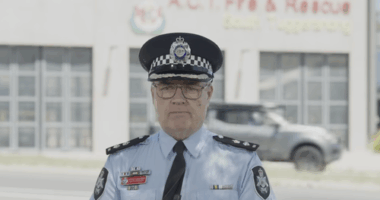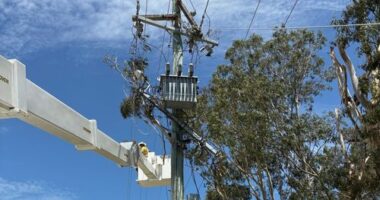Share this @internewscast.com
On a seemingly ordinary morning, the weather bureau released a major flood alert for a rural village at precisely 9:07 am, cautioning residents about the impending danger of surging river levels anticipated later that afternoon.
Just a mere 17 minutes after this warning, Eugowra, a village nestled in the heart of central western NSW, found itself overwhelmed by a devastating flash flood. Survivors likened the sudden deluge to a “wall of water” or an “inland tsunami,” capturing the sheer force of nature’s fury.
Tragically, the disaster that struck on November 14, 2022, claimed the lives of two cherished community members, 60-year-old Diane Smith and 85-year-old Ljubisa “Les” Vugec. In the chaos that ensued, 124 individuals were rescued by helicopter, their lives hanging on the edge as they clung to trees or sought refuge atop roofs.

Leading up to this event, the bureau had a team of up to six meteorologists working diligently on flood monitoring. They were grappling with 43 warnings across Australia, including 14 critical alerts in New South Wales, as the inquest revealed.
In response to the catastrophe, Mandagery Creek has been earmarked for the installation of a telemetric gauge, part of a broader 10-year initiative by the federal government aimed at enhancing flood prediction capabilities.
Though promising, this telemetric gauge’s implementation is currently awaiting various state and federal planning approvals, as noted by authorities. This technology is expected to significantly enhance future flood warnings, providing a crucial layer of safety for communities like Eugowra.
When Deputy State Coroner David O’Neil questioned the “tardiness” of installing the gauge, Collopy said there were 10,000 flood warning instruments across Australia and only a third were overseen by the bureau.
He said the federal program to upgrade warning systems was a “once in a generation” opportunity.
“Without that funding and efforts, it’s been very difficult for the bureau and other agencies to upgrade and maintain this very large network,” Collopy told the coroner.
Water NSW maintained the upstream gauges.
Senior technician Andrew Cutler told the inquest it was an ongoing effort to make equipment as robust as possible to withstand extreme weather.
“If we had the budget, we would have started yesterday,” Cutler said.












